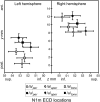Disentangling the effects of phonation and articulation: hemispheric asymmetries in the auditory N1m response of the human brain
- PMID: 16225699
- PMCID: PMC1280927
- DOI: 10.1186/1471-2202-6-62
Disentangling the effects of phonation and articulation: hemispheric asymmetries in the auditory N1m response of the human brain
Abstract
Background: The cortical activity underlying the perception of vowel identity has typically been addressed by manipulating the first and second formant frequency (F1 & F2) of the speech stimuli. These two values, originating from articulation, are already sufficient for the phonetic characterization of vowel category. In the present study, we investigated how the spectral cues caused by articulation are reflected in cortical speech processing when combined with phonation, the other major part of speech production manifested as the fundamental frequency (F0) and its harmonic integer multiples. To study the combined effects of articulation and phonation we presented vowels with either high (/a/) or low (/u/) formant frequencies which were driven by three different types of excitation: a natural periodic pulseform reflecting the vibration of the vocal folds, an aperiodic noise excitation, or a tonal waveform. The auditory N1m response was recorded with whole-head magnetoencephalography (MEG) from ten human subjects in order to resolve whether brain events reflecting articulation and phonation are specific to the left or right hemisphere of the human brain.
Results: The N1m responses for the six stimulus types displayed a considerable dynamic range of 115-135 ms, and were elicited faster (approximately 10 ms) by the high-formant /a/ than by the low-formant /u/, indicating an effect of articulation. While excitation type had no effect on the latency of the right-hemispheric N1m, the left-hemispheric N1m elicited by the tonally excited /a/ was some 10 ms earlier than that elicited by the periodic and the aperiodic excitation. The amplitude of the N1m in both hemispheres was systematically stronger to stimulation with natural periodic excitation. Also, stimulus type had a marked (up to 7 mm) effect on the source location of the N1m, with periodic excitation resulting in more anterior sources than aperiodic and tonal excitation.
Conclusion: The auditory brain areas of the two hemispheres exhibit differential tuning to natural speech signals, observable already in the passive recording condition. The variations in the latency and strength of the auditory N1m response can be traced back to the spectral structure of the stimuli. More specifically, the combined effects of the harmonic comb structure originating from the natural voice excitation caused by the fluctuating vocal folds and the location of the formant frequencies originating from the vocal tract leads to asymmetric behaviour of the left and right hemisphere.
Figures





Similar articles
-
Periodic glottal excitation and formant frequencies in the perception of vowels.Neurol Clin Neurophysiol. 2004 Nov 30;2004:103. Neurol Clin Neurophysiol. 2004. PMID: 16012623
-
Spatial processing in human auditory cortex: the effects of 3D, ITD, and ILD stimulation techniques.Brain Res Cogn Brain Res. 2005 Aug;24(3):364-79. doi: 10.1016/j.cogbrainres.2005.02.013. Epub 2005 Mar 29. Brain Res Cogn Brain Res. 2005. PMID: 16099350 Clinical Trial.
-
Cortical sensitivity to periodicity of speech sounds.J Acoust Soc Am. 2008 Apr;123(4):2191-9. doi: 10.1121/1.2888489. J Acoust Soc Am. 2008. PMID: 18397025
-
The ontogenesis of language lateralization and its relation to handedness.Neurosci Biobehav Rev. 2014 Jun;43:191-8. doi: 10.1016/j.neubiorev.2014.04.008. Epub 2014 Apr 23. Neurosci Biobehav Rev. 2014. PMID: 24769292 Review.
-
Speech processing: from peripheral to hemispheric asymmetry of the auditory system.Laryngoscope. 2012 Jan;122(1):167-73. doi: 10.1002/lary.22370. Epub 2011 Nov 17. Laryngoscope. 2012. PMID: 22095864 Review.
Cited by
-
Sensitivity of the human auditory cortex to acoustic degradation of speech and non-speech sounds.BMC Neurosci. 2010 Feb 22;11:24. doi: 10.1186/1471-2202-11-24. BMC Neurosci. 2010. PMID: 20175890 Free PMC article.
-
Auditory Sensitivity to Formant Ratios:Toward an Account of Vowel Normalization.Lang Cogn Process. 2010 Jul;25(6):808-839. doi: 10.1080/01690965.2010.490047. Lang Cogn Process. 2010. PMID: 20606713 Free PMC article.
-
Transient and sustained cortical activity elicited by connected speech of varying intelligibility.BMC Neurosci. 2012 Dec 31;13:157. doi: 10.1186/1471-2202-13-157. BMC Neurosci. 2012. PMID: 23276297 Free PMC article.
-
You had me at "Hello": Rapid extraction of dialect information from spoken words.Neuroimage. 2011 Jun 15;56(4):2329-38. doi: 10.1016/j.neuroimage.2011.04.007. Epub 2011 Apr 12. Neuroimage. 2011. PMID: 21511041 Free PMC article.
-
The neurochemical basis of human cortical auditory processing: combining proton magnetic resonance spectroscopy and magnetoencephalography.BMC Biol. 2006 Aug 3;4:25. doi: 10.1186/1741-7007-4-25. BMC Biol. 2006. PMID: 16884545 Free PMC article.
References
-
- Fant G. Acoustic theory of speech production. 2. The Hague: Mouton; 1970.
-
- Kent RD, Read C. The Acoustic Analysis of Speech. San Diego: Singular; 1992.
-
- Biermann S, Heil P. Parallels between timing of onset responses of single neurons in cat and of evoked magnetic fields in human auditory cortex. J Neurophysiol. 2000;84:2426–2439. - PubMed
Publication types
MeSH terms
LinkOut - more resources
Full Text Sources
Miscellaneous

